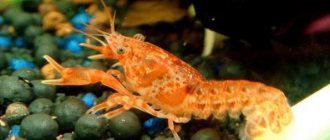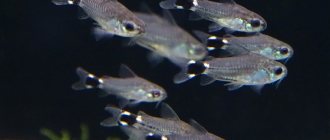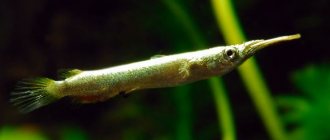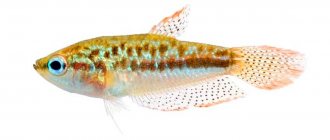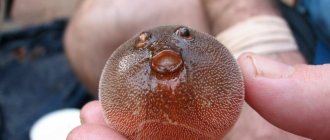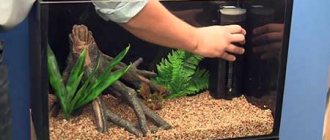Tetradon dwarf, also known as yellow, is the smallest representative of the pufferfish or tetradon breed, which can be found in pet stores. The homeland of this fish is India, and what distinguishes it from other species is that it can only live in freshwater environments. Why do yellow tetradons attract the attention of aquarists? Perhaps, with their beautiful appearance, irrepressible energy, mobility or extraordinary character - small fish are timid and can stand up for themselves. But most importantly, these are very smart pets who themselves are not averse to observing what is going on behind the glass and quickly remember who their owner is.
Dwarf tetradons in their natural environment
Today, fish native to Indian reservoirs are increasingly found on sale: denison barbs, zebrafish, rasboras and other species that have gained popularity among domestic aquarists. But a little further from them is the dwarf yellow tetradon, which was first discovered in the southern Indian state of Karala.
These fish live in the waters of the Pamba River, which descend from the mountains and end up in Lake Vembanad. By the way, these little inhabitants can be found here too. The river has a slow current and rich vegetation - these are the conditions to which yellow tetradons are accustomed. And these inhabitants, unlike other, larger brothers, do not need salted water.
Description of the appearance of the fish
The popularity and demand of dwarf tetradons is largely due to their attractive appearance. The fish have a pear-shaped body , which smoothly turns into a large head. The body is dense, there are small spines that are invisible when the tetradon is in a calm state. Because of them, representatives of the family were called puffers.
If the fish is frightened or anxious, it inflates, takes on a spherical shape, and the spines turn out to be a protective device. However, if an individual transforms frequently, its health may deteriorate significantly. Therefore, you should not scare your pet into pouting.
Yellow tetradon is a tiny fish, reaching a length of 2.5 cm. It has a weakly defined anal fin , while the rest have the appearance of soft rays. Relative to the body, they look miniature and agile, like the wings of a tiny hummingbird. Individuals have rather large, expressive eyes , very mobile. But if they are interested in something, they are able to remain motionless for a long time.
The owners of these extraordinary fish are captivated by their behavior - when they see the owner, they swim up to the glass and begin to carefully examine it. They are also capable of playing and begging for food, making them similar to other pets where such behavior is expected.
mouth is shaped like a bird's beak; their premaxillary and jaw bones are fused. Dwarf tetradons are predators and have 4 plates of teeth, which are located below and above.
Aquarists who first purchased fish of this breed and put them into the tank may notice that their tail is bent. This is a normal phenomenon and signals a protective reaction of individuals. When the new inhabitants get comfortable and become familiar with the territory and the owner, this feature will disappear. In the future, the fish will bend their tail during sleep and rest, or when looking at unfamiliar objects.
Schedule
Strange as it may sound, the tetradon fish sticks to its daily routine. She wakes up when the lights are turned on or with the first rays of the sun at dawn. After warming up their fins, these fish swim up to the front glass of the aquarium and look out for the owner, who must feed them. After a stormy meal, each notebook finds a secluded place, and life in the artificial reservoir calms down. Once full, adult fish fall into a light slumber, and young fish spend all their free time playing.
In the late afternoon, sexually mature tetradons begin to pay attention to their other neighbors. At the same time, the males acquire a darker color and begin to swim around tufts of moss, waiting for the favor of the female and scaring off rivals. Such flirting of the fish continues until about 7 pm. At about 20 o'clock, dwarf tetradons begin to settle down for the night. At the same time, they do not pay the slightest attention to the lighting of the aquarium.
Features of aquarium maintenance
The dwarf tetradon does not need a large tank, however, foreign aquarists recommend calculating the volume based on 10 liters for one individual, and domestic experts say that for a small flock you can use a 30-40-liter aquarium.
The truth is somewhere in the middle, and in any case, yellow tetradons require a smaller tank than their larger cousins. It is important that the environment in the tank is balanced; these fish are very sensitive to ammonia and nitrates. In addition, the following features should be taken into account:
- Adding salt to the water is not recommended . There is no need to add salt to the water; this can harm the inhabitants. And if such a recommendation is found in various sources, it may apply to other varieties of tetradons, except dwarf ones.
- The aquarium requires careful care . These fish cannot be called clean; they leave a large amount of waste after eating. Tetradons do not completely eat any organic food, and its particles remain to rot in the ground. Therefore, it is advisable to equip the tank with a powerful filter and change up to 30% of the total water volume weekly. It is worth taking care that there is no strong current in the tank - tetradons are considered poor swimmers, and they are accustomed to slow water movement.
- Suitable water parameters . Aquarium inhabitants are not very demanding on the parameters of the aquatic environment; they adapt well to existing conditions. The main thing is to exclude sudden changes, which almost all fish do not tolerate well. These guests from India love warm water; it is advisable to keep its temperature within 24°-26°C.
Hunting style
Aquarium tetradons are predatory fish that have a very interesting hunting style. As a rule, they are located above potential prey and carefully examine it, taking careful aim. In a small area around a potential victim, these fish can take it by surprise. Only a few seconds later the tetradon attacks its victim. However, his dash does not always bring success. Sometimes even the coretre manages to avoid a fatal attack. After an unsuccessful attempt, the dwarf tetradon starts hunting again from the beginning.
Are yellow tetradons poisonous?
Researchers were able to discover the closest relatives of pufferfish, and they turned out to be puffer fish. They also belong to the pufferfish family and contain large amounts of toxins. If the cooking technology is violated, it can cause death. But this does not deter experienced chefs at all, and fugu is considered a real delicacy.
As for tetradons, including dwarf ones, they also secrete toxic substances, although not as toxic as those of fugu. Therefore, the owner should be careful when immersing his hands in the aquarium. In addition, pufferfish have very sharp teeth that cut the skin, and a person can suffer quite severely as a result of a bite.
There is evidence that many predators who swallowed tetradon died. This phenomenon is associated not with the toxicity of individuals, but with their ability to swell. The fish increase in size, clog and injure the gastrointestinal tract of the voracious creatures.
How and what to feed small pufferfish
The main difficulty in keeping yellow tetradons is choosing a suitable diet. Aquarists find out from their own, sometimes unsuccessful, experience that feeding these fish with flakes or granules is not recommended. In nature, they eat snails, small invertebrates, and insects. And the menu of aquarium inhabitants should be close to this diet, otherwise the animals will experience hunger. The following foods are best suited for feeding puffer fish:
- small snails: physa, coil, melania;
- frozen food: fish love bloodworms, daphnia and brine shrimp.
Because of their love for snails, these fish are called snailophiles. If your pets are picky and refuse frozen food, you can mix it with live food. Anything that moves is sure to create a huge appetite for these tiny predators.
To ensure that the inhabitants are provided with a sufficient number of snails, it is recommended to breed them separately, since those that live in a common tank can run out quite quickly. And if an inexperienced owner begins to notice that the fish refuse the offered food, but look quite contented and well-fed, and the number of small snails or shrimp has decreased, then the tetradons independently obtain their favorite food.
It is very interesting to watch how tetradons “hunt” for live food. They seem to hover over their prey, take aim and quite seriously begin to attack.
Feeding
These representatives of pufferfish are extremely picky about their diet. Dwarf tetradons feed exclusively on live food, constantly refusing dry granular analogues. The fish diet should include:
- Tubifex;
- Daphnia;
- Bloodworm;
- Artemia;
- Small squids;
- Snails.
Snails play an important role in the diet of yellow tetradons. With the help of the shell of these mollusks, fish grind down their teeth, preventing them from growing too quickly. Therefore, snails should be present on the pufferfish menu every day. It is important to remember that shellfish should only be small in size, not exceeding 1 cm.
Feeding fish should be done 3 times a day. The optimal size portion should be eaten by your pet within 3 to 5 minutes. The remaining time intervals indicate either overfeeding or underfeeding.
Who do dwarf snailophiles get along with?
All tetradons are quite active, mobile and willful, and dwarf ones are no exception. Different owners have opposite opinions about their livability. For some, these small inhabitants coexist peacefully with other living creatures, while for others, they mercilessly eat the fins of their neighbors and terrorize them.
It is best to keep a flock of these bullies separately, without putting anyone in danger. You can add large shrimp to them, but these little pufferfish will feed on small ones. If, nevertheless, tetradons end up in a common aquarium, a spacious container with abundant vegetation will help reduce their aggression. The same applies to their individual content.
Although it is difficult to predict how these little tyrants will behave towards other inhabitants, the best company for them can be called:
- iris;
- otocinclus;
- zebrafish;
- rasborov espey;
- cherry and amano shrimp;
- Ramiresi's Apistogram;
- discus.
But it is not recommended to house yellow pufferfish with the following aquatic inhabitants:
- veiled tails;
- small shrimps;
- guppy;
- platies;
- cichlids;
- predatory catfish.
Compatibility
Dwarf tetradons may behave differently in different aquariums. People often argue about whether to add other fish to them or not. In some situations they get along, in others they eat their neighbors’ fins. Most likely, the matter is in how the fish are kept or in their character that ended up in the aquarium. Aquarists still advise keeping them separately.
The number of individuals in a flock should not exceed 6-7. The aquarium needs to be densely planted with vegetation and provide shelter for fish. In such conditions, it is easier for fish to create a pair.
Reproduction
The dwarf tetradon, unlike most pufferfish relatives, reproduces well in aquarium conditions. Experienced breeders recommend using a separate spawning tank and placing a couple of fish or 2-4 females and one male in it. This will avoid conflicts - tetradons are capable of killing competitors.
The aquarium is prepared as follows:
- It is advisable to equip it with a small filter;
- the water in it is changed regularly;
- Abundant vegetation is placed in the spawning tank.
Expectant parents should be fed heavily with live food and snails. If the male has become brighter, it means he is preparing for spawning. He gives courtship in a unique way: he chases and bites, and when driven into the thickets, the couple releases eggs and milk. The eggs of dwarf tetradons are small, colorless, they do not stick to surfaces, but fall freely. One litter contains about 10 eggs, but females of this breed are able to lay eggs every day.
Individuals can eat eggs, so it is advisable to remove them from the spawning area using a hose or pipette. The fry appear after 48 hours and at first feed on the contents of the yolk sac. In the future, they should be fed with small starter feeds - microworms, ciliates. The offspring grow unevenly, so the owner should sort the fry. Otherwise, larger brothers will begin to eat those that are inferior to them in size.
The dwarf tetradon is a peculiar fish that has a lot of contradictory qualities. Looking at this small creature with big eyes, it is difficult to imagine that this is a serious predator. However, it is enough to introduce the snailfish into a common aquarium to be convinced of this. Therefore, before purchasing fish of this breed, it is worth learning about their characteristics and needs.
Sex differences
Sexual separation of juveniles is impossible because these fish “select” their sex as they mature. Once one Tetraodon begins to become a male, it releases hormones to prevent other fish from becoming males. However, if two fish begin to mature into males at the same time, one of them will become the dominant male.
Both sexes are primarily yellow with dark green or black iridescent spots on the sides and back, but as with other members of the genus, sexual dimorphism appears in mature fish, with males being more brightly colored than females. Males may also have a dark stripe down the center of their pale belly and iridescent "eye wrinkle" patterns, which females do not have. Females are more rounded, generally slightly larger than males, and may or may not have smaller spots between the larger dark markings.



